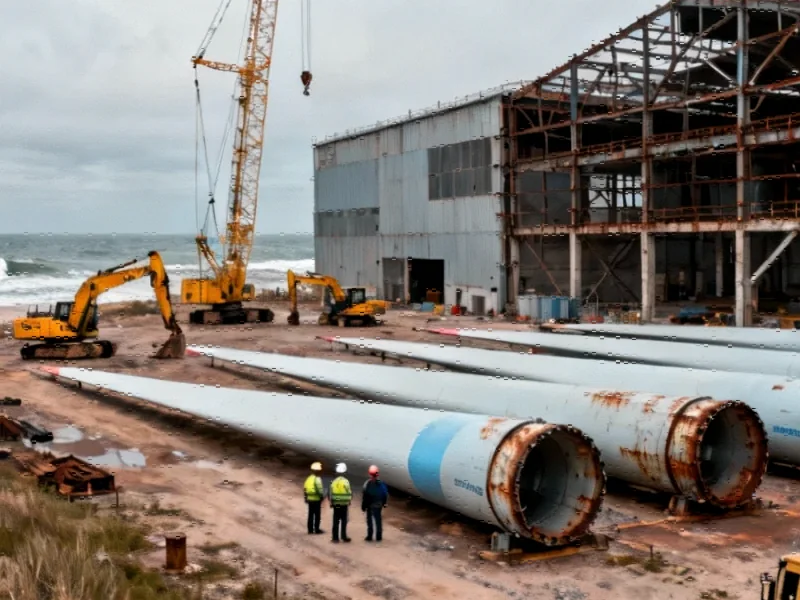European Offshore Wind Sector Faces Critical Juncture
Vestas, the continent’s leading wind turbine manufacturer, has suspended development of what would have been its largest Polish manufacturing facility, signaling broader challenges in Europe’s offshore wind industry. The decision to halt the Szczecin plant investment reveals systemic issues affecting renewable energy deployment across the region.
Strategic Pause Reflects Market Realities
The Danish company confirmed it has “paused due to lower than projected demand for offshore wind in Europe” what was initially planned as a 2026 operational date for the significant manufacturing hub. The facility was expected to employ over 1,000 workers and produce blades for Vestas’s powerful 15MW offshore turbines, representing a major commitment to Poland’s green energy transition.
This development comes amid broader industry challenges affecting multiple sectors, including manufacturing and technology. The suspension highlights how even established renewable energy leaders are reassessing capital allocation in the current economic environment.
Europe’s Offshore Ambitions Versus Market Realities
European nations collectively target at least 129GW of offshore wind capacity either operating or under construction by 2030. However, consultancy TGS 4C projects the region is on track for only about 84GW, creating a significant gap between ambition and execution. Recent failed auctions in Denmark and Germany underscore the market’s challenges.
These market trends reflect broader economic pressures affecting industrial sectors globally. The parallel struggles in different industries suggest systemic issues that transcend individual market segments.
Poland’s Energy Transition Faces Setback
The decision represents a notable setback for Prime Minister Donald Tusk’s government, which has prioritized reducing Poland’s dependence on coal through domestic renewable manufacturing capacity. Warsaw had envisioned the Szczecin facility as a cornerstone of its strategy to transform the Baltic coast into one of Europe’s premier wind energy hubs.
This pause occurs alongside other financial scrutiny in industrial sectors, highlighting how complex financial considerations impact major infrastructure projects. The situation demonstrates how even strategically important projects face rigorous financial evaluation.
Global Wind Industry Recalibration
Vestas’s cautious approach reflects a broader industry trend where manufacturers seek greater certainty before committing to major capital expenditures. Ørsted, the world’s largest wind developer, recently announced plans to retreat from the U.S. market and refocus on Europe and parts of Asia.
These strategic shifts coincide with other sector developments that are reshaping how companies approach investment decisions. The parallel evolution across different industries suggests a broader reassessment of growth strategies in uncertain market conditions.
Supply Chain and Competitive Implications
European manufacturers’ retreat from core markets could create opportunities for Chinese competitors to gain market share. Vestas has emphasized it “continues to invest in a local manufacturing footprint where offshore wind market volume and certainty allow,” indicating a more selective approach to future investments.
This cautious stance mirrors corporate governance developments in other technology-driven sectors, where stakeholders are demanding clearer justification for major investments and executive decisions.
Poland’s Offshore Wind Pipeline Remains Active
Despite the Vestas decision, Poland’s offshore wind ambitions continue with several projects advancing. The €4.7bn Baltic Power joint venture between Orlen and Northland Power, utilizing Vestas turbines, is scheduled to begin operations next year. Warsaw maintains its target of 18GW of offshore capacity by 2040, representing approximately half of Europe’s current total.
These ambitious projects face implementation challenges similar to those affecting other global industries committed to sustainability goals. The parallel struggles highlight how complex supply chain and regulatory issues transcend individual sectors.
Broader Industrial Implications
The Vestas decision reflects wider trends affecting manufacturing investment decisions across Europe. Companies are increasingly prioritizing projects with clear demand visibility and stable regulatory frameworks, particularly in capital-intensive industries.
This careful approach to major investments is evident across multiple sectors, where companies are balancing growth ambitions with financial prudence. The situation underscores how comprehensive due diligence has become increasingly important in today’s volatile market conditions.
Path Forward for European Offshore Wind
European governments are working to improve support mechanisms and offer more attractive terms to developers, recognizing offshore wind’s strategic importance for energy security and climate goals. However, the sector outside China continues to struggle with profitability, compounded by political opposition in key markets like the United States.
The Vestas pause serves as a reminder that even promising renewable energy initiatives must navigate complex economic realities. As the industry matures, manufacturers and developers alike are adopting more disciplined approaches to growth, potentially creating a more sustainable foundation for long-term expansion.
This article aggregates information from publicly available sources. All trademarks and copyrights belong to their respective owners.
Note: Featured image is for illustrative purposes only and does not represent any specific product, service, or entity mentioned in this article.



